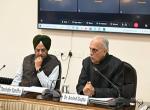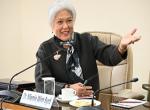Change Language
Geopolitical Dynamics of the Post COVID-19 World


Vivekananda International Foundation held an online discussion on ‘Geopolitical Dynamics of the Post Covid-19 World’ on 29 May 2020. The discussion was moderated by Dr. Arvind Gupta, Director VIF and the panellists included Lt. Gen. Ata Hasnain, Amb. Kanwal Sibal and Dr. Sanjaya Baru. The discussion was followed by an open house Q&A session. Prior to the discussion, a concept note and 13 questions were circulated to the panellists.
The takeaways from the discussion are listed out below.
Balance of Power and New World Order
- The overall sense of the geopolitics in the COVID situation seems to lead towards a situation where the balance of power focuses on different regions without compromising on the old world relations. The crux of the issue overall is the balance between public health and economy which will impact social harmony in the nations.
- The development of the vaccine will lead to ‘Vaccine politics’ which may lead to cooperation or competition since MNCs will gun for profit.
- Internal will override the external. Internal affairs will take a long needed precedence over the external issues. National policies are taking precedence over international policies. Countries which are more globalized will end up being impacted more and here we now see a segregation of geopolitics and geo-economics. The world will see more narrow interpretations of policies especially in the West. This will to some extent get mitigated by the power of the multinational corporations.
- Companies and nations which are heavily invested in China will find it difficult to get out of the Chinese market. They may seek to diversify and move out, but the existing investments will likely remain, except in the pharma sector which has exposed vulnerabilities eg in USA.
- Essence of the New World Order would be USA and a China which is unpredictable and unsure of how far to go and how fast. A classical new world order is unlikely. Comprehensive National Power (CNP) of USA is too high to be impacted beyond a point. The gap between the USA and other countries is simply too much. The rise of China is a long term phenomenon as is the decline of the West. The East vs West rivalry will not go away.


China
- China’s worst fear would be conflict and dilemma therefore, on whether to renege on the 1991 Hongkong agreement or on Taiwan. It will play on the victim perception with 132 countries ganging up against it in international fora. The major issue China will face is in recovering trust in the world.
- In the Galwan Valley case, China is trying to recover from an image deficit post the media touted ‘defeat’ in Doklam. They will go up to a point and not beyond.
- South China Sea has been violated asunder by the Chinese belligerent acts like the sinking of the Vietnamese vessel and several such other acts. The ASEAN will now find it difficult to formulate any kind of Code of Conduct hereafter. India must engage more in the South China Sea.
- China seems to also be creating an alternate system of multilateral organisations like the 17+1 dialogue of China with Eastern and Central European countries, China’s Dialogue on Asian Civilisations and a number of others using the OBOR initiative. OBOR itself has spawned a number of organisations like for tax cooperation, customs cooperation and so on.
- China’s policies towards India bilaterally or multilaterally are not positive at all. We have got no value from BRICS, RIC or SCO rather these organizations provide more space to China to pursue its ambitions, though they do offer some benefits to India as a platform to air Indian views. China is aiming to convert economic might into political influence. They are trying to maintain innovative advantage over the rest of the world. They are also trying to create the capacity to influence the key global institutes.
Impact on the Middle East
- A new Arab Spring is a possibility and even the 2022 Qatar World Cup now looks debatable. This is primarily due to the reduced price of oil with supply exceeding demand.
- India, US and Japanese strategic relationship needs to be strengthened and Russia must feature in India’s foreign policy as before. Quad needs to be strengthened and India has every reason to pursue the Quad which might lead up to the Indo Pacific partnerships.
Neighbourhood and Alliances
- How the post COVID world will pan out, is a function of how the governments deal with their domestic challenges. There is a need to make India more attractive and hospitable to draw in investment, especially those wanting to quit China but not Asia. India’s neighbourhood policies have largely been successful. The neighbourhood policy cannot be judged by Nepal alone. More regional agreements on the lines of RCEP equivalent are required. Just touting India’s vast market will not suffice especially in a post COVID scenario. The importance of Asia in the future is evident including the RCEP. India has signed no major trade agreement in past few years. There is a need to guard against getting left out of the Asian rise.
- If we look at Indo Pacific as a strategic area then we should also look at a maritime strategy for the Indo Pacific, but there is no trade strategy to balance that, it does not work. Security and trade must balance out.
- FTAs and alliances do not really impact the informal sector which is 90 % of our work force. Thus job oriented policies are going to be the flavour of the day. We need to build our internal strengths to deal with our likely adversaries.
Need for Technology
- We need to guard against USA going back to an intrusive and restrictive technology transfer regime. Technology is what India will need right now. Technology is a new battle front which requires investment, both public and private, if India is to attain ‘atmanirbharta’.
- Storage of strategic oil reserves. India has a number of defunct oil fields which are potential oil storage sites which can be used for storing our strategic reserves.
Event Date
May 29, 2020
Contact Us










Post new comment